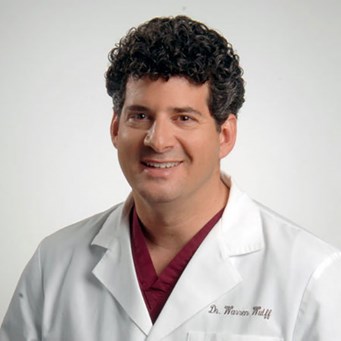 By: Dr. Warren Wulff, SOS Neck & Back
By: Dr. Warren Wulff, SOS Neck & Back
As spine surgeons, my colleagues and I strive to find the most conservative means of effectively managing patients’ back conditions. We want the best outcome for our patients with the least intervention. To achieve this, we always start with the basics: a thorough patient history and examination. What a patient can tell their surgeon about their condition is a primary concern so a detailed conversation between the two is necessary. One of the most common requests I hear from patients during such discussions is a desire to be treated with minimally invasive techniques.
As a spine surgeon with 20 years’ experience practicing at SOS, I have seen a significant progression and evolution in therapies this field. While the problems patients face regarding their spine health has largely remained unchanged, our approach to managing those problems continues to evolve. Significant advances in medical knowledge and technology have led to a proliferation of new - but not necessarily better - techniques. Some of these techniques and procedures are truly marvelous innovations. Others are - for lack of a better description - scams. How is a patient suffering from an acute or chronic spinal condition expected to tell the difference? It can be difficult, and I’d like to provide advice based on the knowledge I’ve gained in my years of practice and continued education.
My best advice is to develop lasting and meaningful relationships your primary physician. He or she knows your specific health concerns and also knows the reputation of the specialists to which they might refer you for more advanced care.
Beware of the Internet. Yes, “information” is out there. Some of it is legitimate, but some of it is fraudulent or at the very least commercial marketing. As consumers become increasingly sophisticated with internet research, so does the complexity of marketing campaigns. Patients may think their “research” has provided them with objective data, but instead are being led to a conclusion which profits the publisher of the website. Very often patients approach me with specific requests or questions about procedures, devices or medications which they learned about on a sleekly designed sales website camouflaged as a medical information site.
Unfortunately, minimally invasive spine surgery lends itself to predatory marketing. Perhaps the biggest example in recent years was the rapid proliferation of laser spine surgery centers. They promised quick solutions for many patients using lasers. These centers required patients to pay a large amount of cash up front, and they did not accept insurance. Through unethical marketing and testimonials, laser spine surgery centers enjoyed considerable financial success until abruptly closing in March 2019 under a crush of lawsuits, which forced them into bankruptcy.
There is hope. The vast majority of spine surgeons you may visit are truly trustworthy, caring physicians who offer safe and well-planned strategies for treatment and recovery. Each patient is different and requires a different approach to achieve their goals. Reputable surgeons take into consideration an individual’s specific spine problem, overall health concerns and desire to consider surgical options after failure of more conservative treatments.
Not all spine problems can be treated with surgical procedures, but some can. It is the surgeon’s responsibility to appraise a patient of surgical options, their potential risks and benefits, and provide trustworthy resources for more information. This can be a time-consuming discussion but it very important and worthwhile. Whenever appropriate I will guide my patients to the least invasive procedure that has demonstrated good, predictable outcomes. Certainly some procedures are less invasive, but they must be effective, as well.
Personally, I love performing minimally invasive spine procedures. Mastering them has changed my practice and kept my sustained interest in a spine surgery career. When necessary for an individual patients, I will perform larger, traditional, open spine procedures; but my strong preference is to find a less invasive option for my patients. In recent years, approximately 70% of my patients are able to go home within hours of their procedure or by the next morning. Most of my cases can be safely performed at an outpatient surgery center. SOS is proud to offer minimally invasive spine procedures at the newly opened, state-of-the-art, Specialists One Day Surgery Center in North Syracuse.
Over the last 20 years I have continuously monitored the evolution of surgical techniques and technology. I have done the research and studied the science. I have adopted procedures that are safe and effective and I have rejected the rest. I am constantly scanning the horizon for the next one. In order to make the cut, a procedure needs to be safe, effective and have endured the test of time.
When appropriate to your circumstances the following procedures are currently offered using minimally invasive outpatient techniques at the Specialists One Day Surgery Center:
Microscopic Lumbar Procedures
Discectomy -removal of a herniated disc fragment
Foramenotomy - decompression of a pinched nerve
Laminectomy- decompression of a pinched spinal cord (stenosis)
Laminotomy - less invasive version of laminectomy
Scar tissue removal - removal lysis of adhesion procedure
Bone spur removal - only needed if it's pinching a nerve
Cyst Excision - synovial cysts from arthritis
Neck Procedures
ACFD - Anterior Cervical Discectomy and Fusion, up to three levels
Disc Replacement - usually reserved for younger patients with no arthritis.
Mini-Open Lumbar Procedures
TLIP/PLIF/XLIF - interbody fusion with specialized implants and instruments
Spinous process- Spinal decompression and stabilization without fusion stabilization
SI Joint Fusion - fusion of the sacroiliac joint
Neuromodulation
Dorsal Column Stimulator Implants - for chronic nerve pain of most any cause
The spine surgeons at SOS can tell you if you might be a candidate for any of them. Remember, not all spine problems can be treated with surgery and not all surgery can be done with minimally invasive techniques.
More information about these techniques is available at www.sosspine.com.
